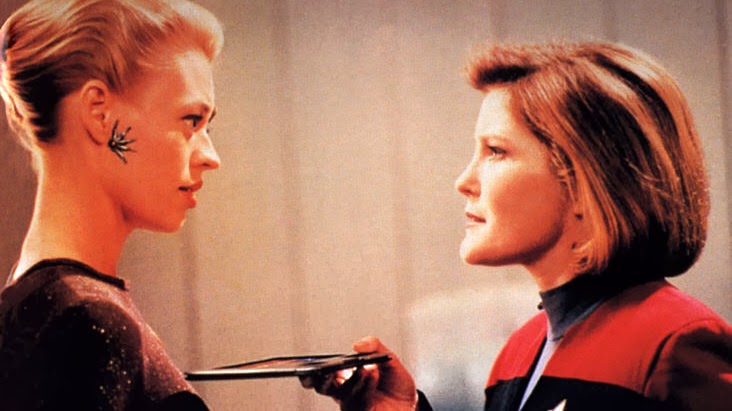Hey there! Its Dita again! Besides being a sickening drag diva by night I have an alter ego in me that says: "Dita, my darling, take things not for granted and thing them through another time!" And in order to oblige this I will now bring you some geeky nerdy feminism fun! So lets get going! =)
Lets make one thing dilithium crystal clear before we engage on this warp speed flight: Star Trek, and in particular Star Trek Voyager, is not just geeky, nerdy technic stuff and definitely en-vogue. Period. Actually, Star Trek has been, and still is, a vessel to bring queer ideas, gender-bending performances and new, unconventional, ideas directly into the spotlight of the heteronormative, (usually) misogynistic and discriminating discourse of mainstream media.
Star Trek Voyager, launched with major differences to the other series of the Star Trek franchise, is probably the most complex and daring series of the Trekkie universe. Not only is it set 70.000 light years away from the Alpha quadrant but it as well introduces strong female characters in leading roles, including that of the captain. Through out seven action filled, science packed, and heart fealt seasons Captain Janeway navigates her crew through endless battles with the Borg, Species 8472, the Kazon, marco-viral infections, temporal anomalies and occasional time travel. Along its way Voyager picks up two more, strong, female characters: Ocampa Kes and Borg drone, turning human again, Seven of Nine. So, for all you Star Trek enthusiasts let’s have a look at the darinmg and complex relationship between Seven of Nine and Captain Janeway.
Right from thee offset, it’s worth noting that physically, Seven of Nine is very much what the heterosexual mainstream desires and demands of women: a perfectly shaped body and a hyper-sexualized performance of it. Add the tight, sexy and definitely uncomfortable cat suits Jery Ryan had to wear playing Seven, and the critique points of the character as exploitative, sexist and flat-lining as a simple “rating-upper” gain tremendous momentum. However, on closer examination our tricorders find that the misogynist and anti-feminist façade of Seven is just a façade. As a matter of fact Seven offers a whole new dimension of queer readings, desires and possibilities for the series. But in contrast to her hyper feminine appearance, Seven displays a high level of androgyny, caused by her Borg background. Her gender performance certainly lacks the characteristics aligned with the notion of femininity as weak, mind troubled, stupid and hopelessly lost – Seven is the complete opposite.
Yet, before assimilating Seven of Nine more, let’s sum up the character Captain Kathryn Janeway. Critics often commented that she is a very strong, almost manly, character that constantly deals with an ambiguity between masculinity and femininity. Labeled as “too much of a dominant character”, Janeway’s portrayal was seen as an exaggerated stereotype of a ball-busting feminist. However, what critics were mostly unaware of is that Janeway was never meant to be a female character that embodies feminism as it is to be expected. Her puropse was to be an archetypal character that represents feminism, femininity and female empowerment in an uber strong manner with the purpose of really embedding the idea of powerful women in positions of power. For the 90′s that seemed a bold decision. In addition Janeway combines some masculine and some feminine performance patterns so her overall gender performative remains fluid.
Both, Janeway’s and Seven’s, unusual character and gender performance makes it so interesting to take a close look at their ambiguous relationship. As Seven first comes aboard Voyager it is clear that Janeway has made it her personal mission to be Sevens mentor on her journey to re-discover her humanity and individuality. All along that way the audience gets to see more and more that this mentor student relation is not at all a usual one way communication. Sevens knife sharp mind and immense knowledge make her a teacher of knowledge for Janeway in the very sense as much as Janeway is a guide for Seven in what it means to be human and individual.
During their journey through the Delta quadrant Janeway developes motherly connections towards Seven, as she did years before for her chosen family: the crew of Voyager. Seven on the same part allows their relation to grow on a personal level, but not being an empty canvas for Janeway rather a discussion partner. And , even if Seven hardly acknowledges it, she partially grows into the role of Janeways daughter, a sometimes defiant one. Seasons six and seven see Seven emotionally attaching to Janeway as a friend, subtext wise to be interpreted as a (maybe) lesbian romance. Episodes like “The Dark Frontier” strengthen this idea as Janeway is on a quest to rescue Seven after she was forced to re-join the Borg.
As mother figure and mentor Janeway succeeds in helping Seven developing into an individual, maybe not as completely as planned but still a unique character. As the Voyager manages to save four children from the existence of a Borg drones Seven even , once again first reluctantly then passionately, takes over the role of the mother figure herself.
Recapped, the relation between these two strong and gender fluid characters has changed botch characters. The Janeway Seven relation has several layers of possibilities and readings to be found by the willing reader, that makes the effort. Further feminism and femininity have been implemented in a gender queer and fluid discourse, where expected the least: prime time TV. And if that is not what you might have taken away from it: hurry up, go watch Star Trek Voyager. Because there is plenty more to discover, and always remember: “Resistance is futile!”

No comments:
Post a Comment